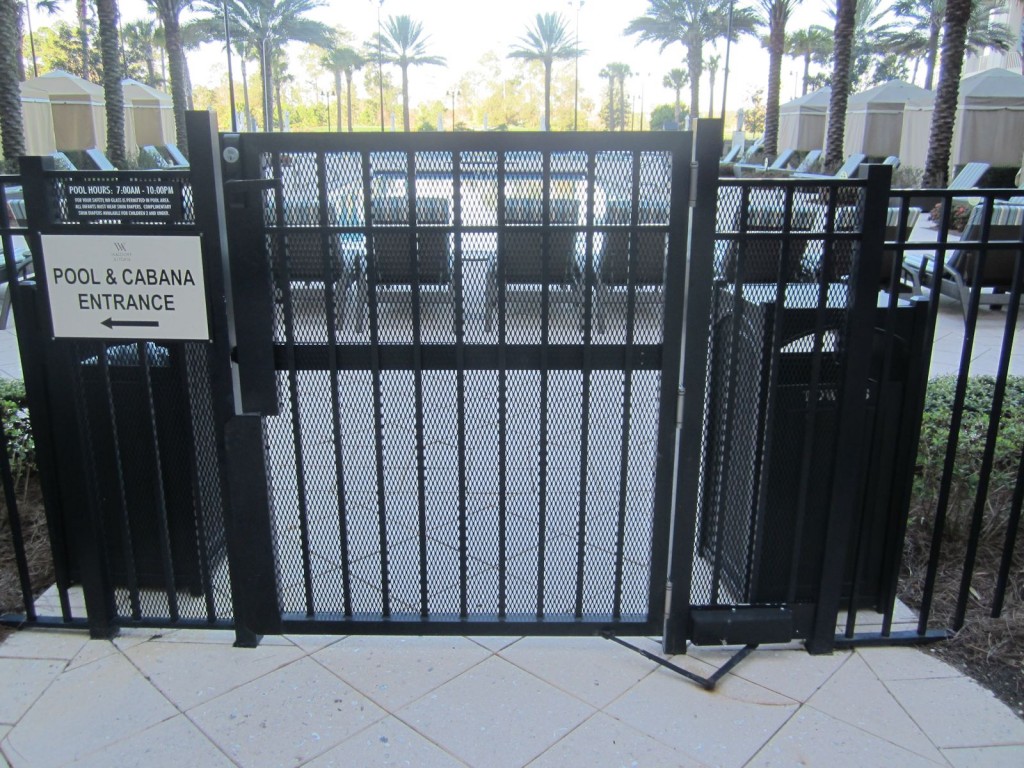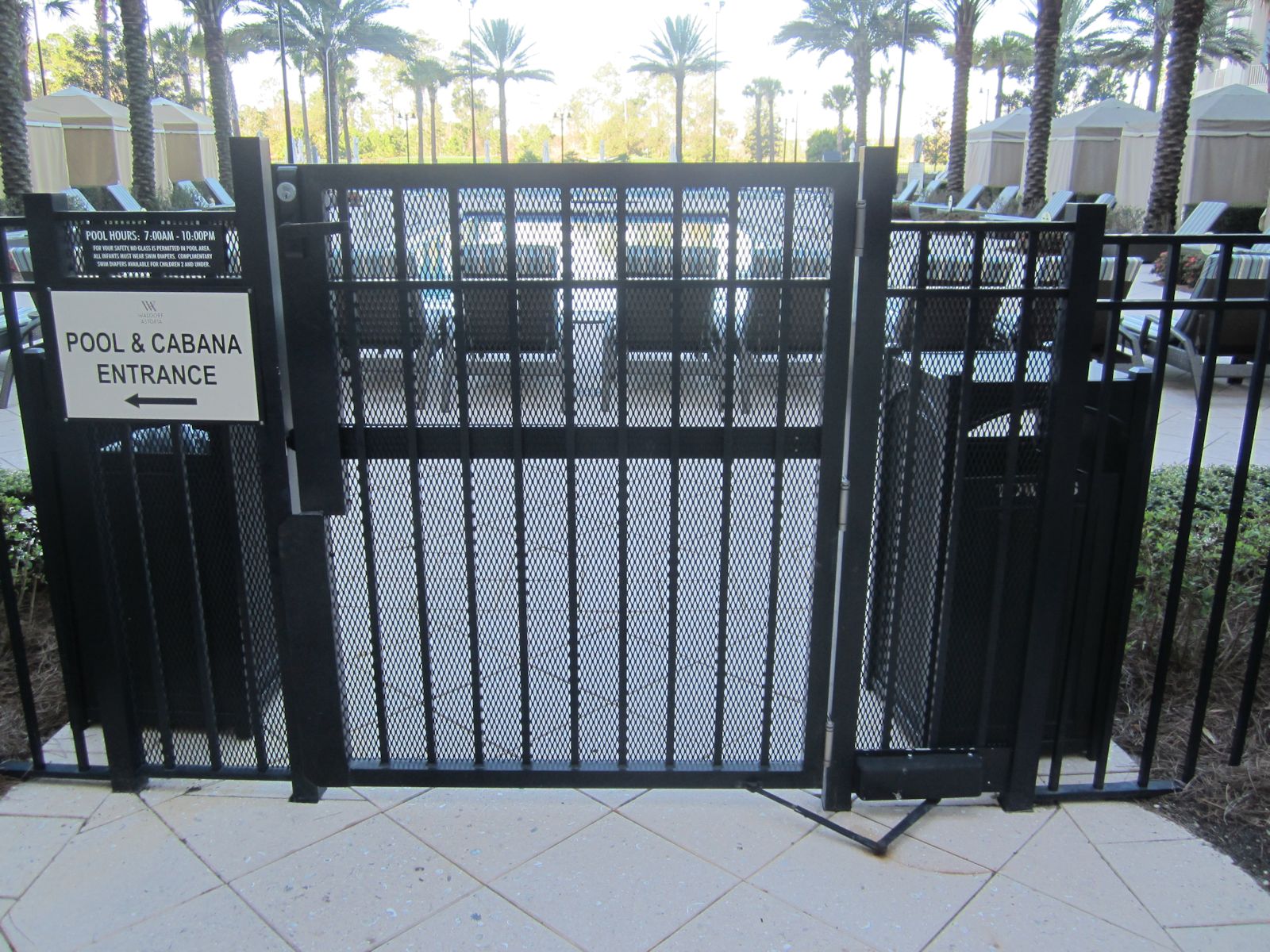 I know that much of the US is beyond swimming pool season, but this question just came up again so I’ll leave it right here for you to find when you need it.
I know that much of the US is beyond swimming pool season, but this question just came up again so I’ll leave it right here for you to find when you need it.
A few years ago I saw a pretty ingenious application for swimming pool gates, where the access hardware was required to be mounted at 54 inches to prevent small children from entering the pool enclosure, but the egress hardware had to be mounted between 34 inches and 48 inches above the floor. The photos and description of that application are here.
Many of these swimming pool applications require access control, so one question is – what is the best access control application? Electric strike? Electromagnetic lock? Electrified lever trim? Please feel free to leave a comment if you have a preferred solution.
While I was looking into the access control situation, I asked the ICC for help with interpreting the 2015 IBC section that addresses the height of hardware on pool gates:
1010.1.9.2 Hardware height. Door handles, pulls, latches, locks and other operating devices shall be installed 34 inches (864 mm) minimum and 48 inches (1219 mm) maximum above the finished floor. Locks used only for security purposes and not used for normal operation are permitted at any height.
Exception: Access doors or gates in barrier walls and fences protecting pools, spas and hot tubs shall be permitted to have operable parts of the release of latch on self-latching devices at 54 inches (1370 mm) maximum above the finished floor or ground, provided the self-latching devices are not also self locking devices operated by means of a key, electronic opener or integral combination lock.
This section requires hardware (all operable hardware – not just on pool gates) to be mounted between 34 inches and 48 inches above the floor. The exception allows hardware on pool gates to be mounted above this height, at 54 inches maximum above the floor or ground. The part that confused me was this: “provided the self-latching devices are not also self locking devices operated by means of a key, electronic opener or integral combination lock.“
What does this mean? In code language it’s saying that you can’t apply the exception and mount the hardware at 54 inches above the floor if the gate has self-latching hardware that prevents unauthorized access from the outside. It would have been more easily interpreted if the exception stated that the 54-inch mounting height is not required when that hardware is used.
Given the potential for confusion, the ICC gave me permission to post their response to my question:
ICC Staff Response: There are two aspects to consider with locks on doors or gates providing access to a pool area – pool safety and accessibility. Where the gate has a latch only and no lock controlling ingress, then placing that hardware at 54” above the floor decreases access to the pool by small children. Where the gate hardware also had a locking function and a key or fob would be needed to unlock the hardware to allow unlatching the latch, then the hardware can be within the accessible reach range. Access to the pool would be limited to those with a key or fob so child safety is addressed that way.
It’s pretty clear that the intent of the code was to allow the hardware on the outside of the gate to be mounted between 34 inches and 48 inches if access to the pool area is restricted to those with a key, code, or other credential. This will likely be addressed in a future edition of the IBC and/or in the Commentary, but until then it will be up to each AHJ to interpret whether the hardware on the access side of the gate needs to be mounted at 54 inches.
Using the pool gate that I originally posted about as an example…as this pool was part of a resort and the gate was left unlocked during the day, the access-side hardware would have to be mounted at 54 inches. If the gate required resort customers to use their room card to access the pool and the gate closed, latched, and locked each time it was opened, the access-side hardware could have been mounted between 34 and 48 inches. Make sense?
You need to login or register to bookmark/favorite this content.






Normally see this::
http://ddtechglobal.com/product/magnalatch_top_pull_model_series_3
That’s a common safety latch but some facilities want access control with codes or cards, and less common nowadays…keys.
Thank you Lori! That really cleared it up the actual code requirement part of it, much appreciated!
The 54 inch height exception says “shall be permitted” which sounds optional, as opposed to “shall be…” That does not square with the conclusion “the access-side hardware would have to be mounted at 54 inches.”
I think the 54-inch requirement is coming from the section on pools, although it is also a little confusing:
3109.4.1.7 Gates. Access doors or gates shall comply with the requirements of Sections 3109.4.1.1 through 3109.4.1.6 and shall be equipped to accommodate a
locking device. Pedestrian access doors or gates shall open outward away from the pool and shall be self-closing and have a self-latching device. Doors or gates other than pedestrian access doors or gates shall have a self-latching device. Release mechanisms shall be in accordance with Sections 1010.1.9 and 1109.13. Where the release mechanism of the self-latching device is located less than 54 inches (1372 mm) from the bottom of the door or gate, the release mechanism shall be located on the pool side of the door or gate 3 inches (76 mm) or more, below the top of the door or gate, and the door or gate and barrier shall be without openings greater than 1/2 inch (12.7 mm) within 18 inches (457 mm) of the release mechanism.
I have a different pool situation. The country club has two pools. One indoors, the other outdoors. The entrance to the outdoor pool is through the indoor pool area. The fire marshall does not want free egress from the indoor pool into the outdoor pool area. This door has an exit device on it at this time. There is not exit sign over the door, so it is not an “official” means of egress.
Can I just secure this door with a deadbolt that is to remain locked during closed times for the outdoor pool?
I would suggest confirming with the fire marshal what would be acceptable. If it’s truly not a required exit, then you could put a double-cylinder deadbolt on it, but he might want you to take off the panic hardware or add signage stating “Not an Exit.”
– Lori
Per your original Pool Gate post, IBC states:
“…..pool enclosures must be at least 4 feet high, with gates that are self-closing and self-latching. Gates must swing away from the pool, and the release mechanism on the outside must be at least 54 inches from the bottom of the door or gate to prevent a young child from entering.”
How do you mount a release mechanism at 54 inches from the bottom if the gate only has to be 48″ tall? Just curious.
The IBC says the top of the barrier has to be “at least 48 inches above grade” so I guess the gate would have to be higher to accommodate the 54-inch mounting height.
– Lori
let’s make a dumkopf exception for a homeowner who wants to save a buck on his own back yard pool, but who in their right mind would put a pool fence in, less than 5 feet tall above finished floor in a ‘public’ pool setting ?
I didn’t notice any mention of egress requirements from inside the pool area to an area outside of the gate. NFPA Life Safety Code requires egress to be “without the use of a key and/or special knowledge”. This goes for both interior enclosed areas and outside enclosed areas. As a fire marshal, I am constantly battling pool managers that require the use of a key to exit the pool area.
You’re right! Free egress is sort of a given around here…I will make an edit to the blog post as a reminder.
– Lori
Didn’t see your blog post edit regarding free egress.
Having trouble finding a code reference to whether a REX button for a pool gate exit is acceptable. If so, I would assume it would have to tie in with back up power to be allowed? Can anyone point me to the appropriate code?
Tom
so here’s what i do, folks..
overhead frame surrounding pool gate gate, top of pool gate within 1″ of
overhead. standard door closer mounted in parallel arm configuration. done
properly, the gate will close to it’s stop position without fail. (noted
exceptions for propping gate open, jamming debris in strike – i call that
vandalism and not within warranty nor would i consider myself liable as an
installer.) assuming proper strike adjustment and sufficient latch guarding,
a clutching storeroom function lever on the outside and sufficient shielding
of the inside lever, it’s “one and done” 🙂
I would highly recommend using a Mammoth 180 ADA compliant self-closing hinge as the gate closer on all pool installs. Zero callbacks on Locinox and its a very easy and quick install!
I have a patio or courtyard home with pool in front of house with a typical front door like access to the pool area first then to what is my front door inside inspector is requesting that the door swing away from pool since its like a gate what is everyone’s thoughts
I have run into the same situation with the gate door having to swing away from the above ground pool (just installed 2019) in the backyard. Apparently that is the new “code” that is being enforce in Michigan. I will make that work, but I am struggling finding a good door/gate to use for reasonable that is premade. I may have to build my own, but it would be nice if anyone had suggestions for a gate door that is 48 inches high and at least 3 feet wide that folks have used in their applications.
I’m at hotel and they they shut key card of for pool at ten. I wanna sneak in with my gf what’s best satgestion